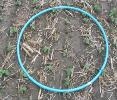
My wife spent $5 for a large-size hula-hoop at a major department store. My daughter bought me one for a buck at a dollar store. It's only 27 inches in diameter, but it will still work, developing stand count information in soybean fields. Now that the weather has cleared some and soybeans planted in early to mid-May have had an opportunity to emerge, this is likely a good time to visit fields and determine counts. If you're going to do any replanting, the sooner, it's done, the better the odds that it might return a positive return. That's a story for another day.
Right now concentrate on getting good counts. Shaun Casteel at Purdue University says you can use the hula-hoop on both solid stands and 15-inch rows. If you don't have an actual hoop, you can make one out of number nine wire. The key is to have it perfectly round, and know the diameter of the hoop.
The Purdue University Corn & Soybean Field Guide developed by the Purdue Diagnostic Training Clinic contains instructions and tables on how to sue the hoop. Find them on page 108 in the 2010 edition. Here's an example.
Suppose I roll my 27-inch bargain hoop five times at random location in a 15-inch row field and find an average of 13 soybean plants per hoop. The conversion factor for turning that count into average stand count for plants counted inside a 27-inch diameter hoop is 10,961. So my average population is 13 times 10,961 equals 142,493.
That's still far more than the charts say will return top yield potential. In fact, there are people pushing the planting population down near 140,000 plants per acre. In the field where I took these counts, the planting population averaged 168,500 per acre. At 90% germination and 90% emergence, the variables assumed for years by soybean specialists, the expected stand count would be 136,485. So in this example, there was obviously better germination and or emergence than the twin 90's to produce this stand.
Suppose we used a 30-inch hoop and counted 18 plants. Since the hoop contains more square inches, the multiplication factor will be smaller. For a 30-inch hoop, the factor to multiply the average count of plants inside the hoop by is 8,878. That means that in this case, the expected count would be 159,400.
In either case, both stands are far more than is needed to achieve 100% yield potential.
About the Author(s)
You May Also Like




